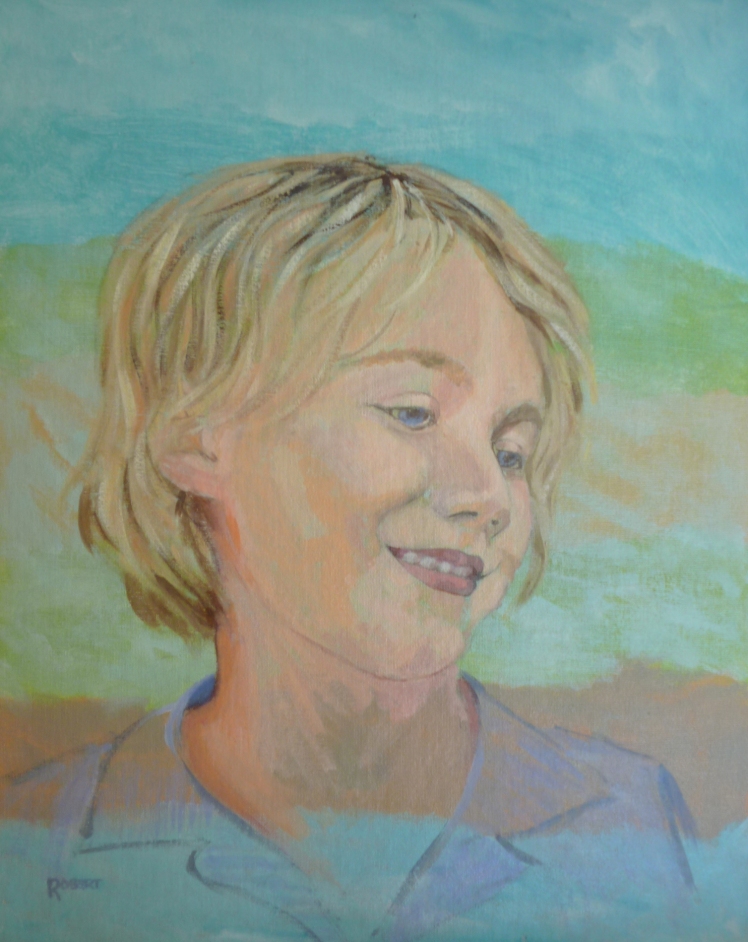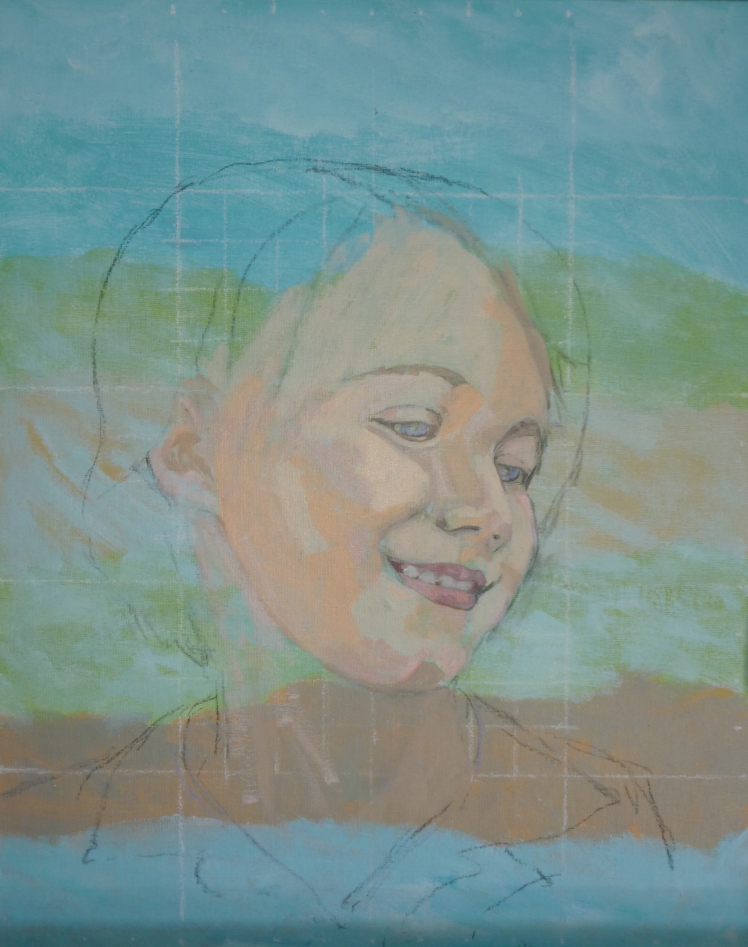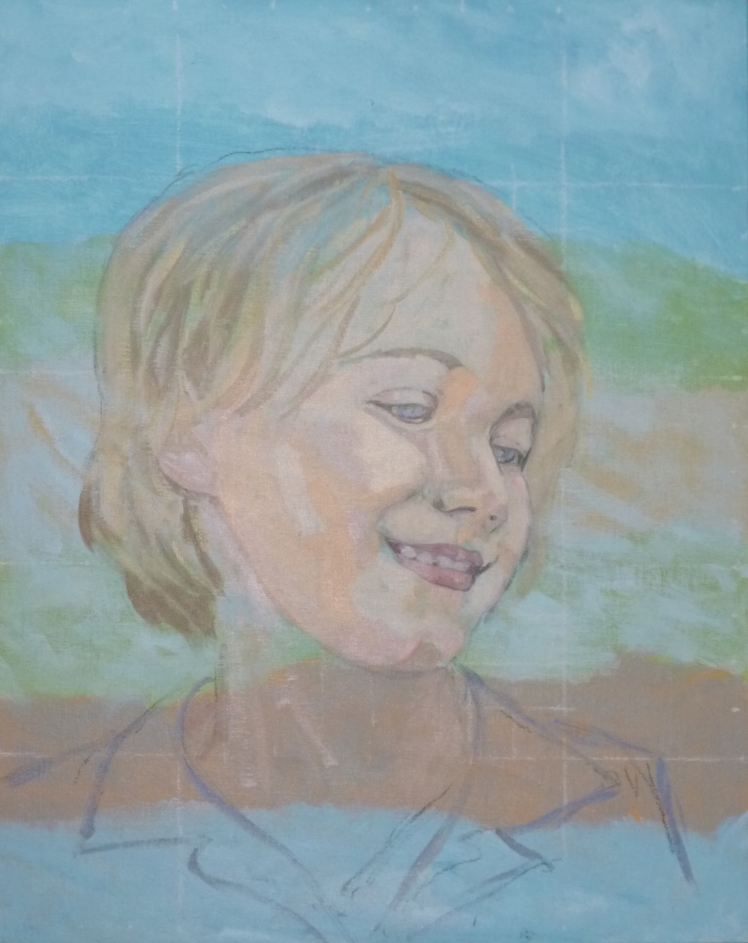So, what have I learned from the process of these four paintings? Such a change from seascapes! It might sound obvious, but here goes. Drum roll…..

The first stage is the most important. Actually it is crucial. Once the charcoal drawing looks ‘right’ in terms of its likeness to the subject, it is time to paint in the eyes, nose and mouth. This has to be done before the excitement of slapping on too much paint. It is too difficult later to regain control of wandering eyes, loose lips or sniffy noses!
Theoretically then, you can stop painting when the composition feels right.The likeness is there and from that point you are working with the canvas and the basic elements of the painting.
Knowing when to stop, ah yes! That’s another issue. Sometimes the customer plays a role in that. The first stage might be cut and dried, but the final stage isn’t as clear. What do you think?



Superb Philippa, truly superb. I can’t answer your question as I suck at portraits. However, in any painting the final stage, the ending, is dodgy. For me the process is ongoing. I might think I am done, but then a month later I look again and need to apply more or take away. Someone said that a painting is never finished – it just stops in an interesting place…
What a lovely thought! There is a story about an Australian painter Jeffrey Smart who used to carry brush and paints and touch up his own paintings on gallery walls. Gallery owners were not very fond of that. Smart, now in his 90s I think has declared recently that he has painted his last work. I saw it a couple of weeks ago at his retrospective, but no sign of him, brush in hand. He is safely in Italy!
And what a marvelous place to end one’s painting career – my heart has always been there…
its wonderful,so fresh and lively. full of air.
Thank you Helen! Great that you get that feeling.
Lovely, just lovely – and i really like the angle of the head and the direction of gaze, and the way the curves echo eachother as if rippling out from the dimples. Wonderful!
So beautifully drawn that the paint seems superfluous. It actually reminds me of your seascapes. Brava!
Maybe too much teeth–I noticed them right away, and am thinking I should not have. I don’t mean change the drawing. Just more shadow on the teeth?
I think I know what you mean Aline. Teeth are a dangerous inclusion! I went back to reshape the teeth and may have highlighted them in doing that.
Wow! From a non- painter perspective it is fascinating to see the development of this stunning portrait. I love the wistfulness of the first two, all of which come together with striking purpose through the waves of the background.
Thanks Patti for commenting. Interesting that you respond to the early stages too. I quite like the face emerging from the amorphous background like a sculpture appearing in stone. I’ll try to stop earlier next time!
Beautiful painting Philippa, I really love the colours you have used, they give your painting an ethereal air, especially in the early stages.
Thank you for your kind comments Rachael. Nice to hear from you!
I’m catching up on a backlog of blog reading, so forgive my tardiness in congratulating you on all four of the portraits/likenesses. Art as performance and knowing when to stop is such a wonderfully profound area of discussion, isn’t it? My husband is a composer, so he’s perhaps more like you in having, at some point, to let go of his creation. As a singer, I’m never presenting truly completed products, only products at a point in time. (Unless, of course, I’m lucky enough to do a first recording of anything, when that might be considered definitive; but it is still, as Jessye Norman once said an interpretation that was valid at that time but might not be how anyone would perform it now.) Capturing the faces of people at a point in time is surely a similar thing? I’m utterly fascinated by the progress shots. Thank you for sharing. Oh, and Happy New Year.
Felicity, thanks for your thought-provoking comments. I agree that knowing when to stop is critical. For me, it might be just the act of stopping! Not really sure where the bells and whistles are that mark the boundary, so ‘knowing’ when to stop is elusive. Some pieces never feel finished, but if they are taken too far past the invisible finishing line, retrieval of their essence becomes very difficult! Perhaps what you say about a point in time is the reason. Can’t re-jig something with later learning? Quite a conundrum. Hindsight, ah!